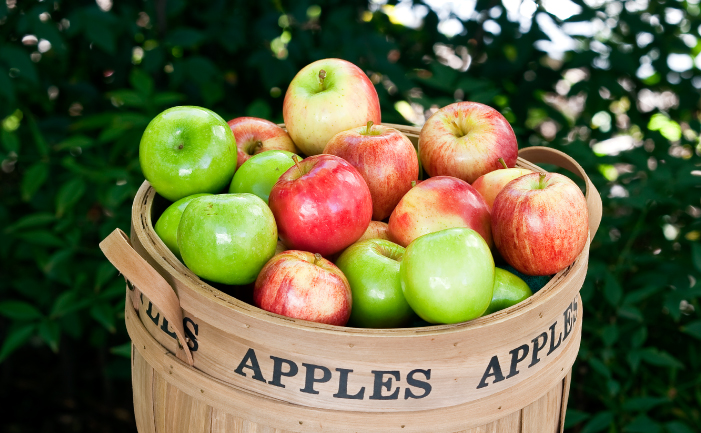Lots of people of all ages would happily say that apples are their favourite fruit. Whether you eat them fresh and crisp as a snack anywhere, anytime, or turn them into a crowd-pleasing dessert that always gets demolished, these fruits will always be super-popular.
Yet despite their popularity for eating, only a small proportion of gardeners have a go at growing apples, mostly because the climate isn’t right. Apples definitely do best in our cooler climate zones, but they really ought to be planted more often in these areas, because an apple is a genuinely useful backyard tree.
A full-grown apple makes a good, medium sized (6-8m tall) shade tree for summer that announces the spring with a show of blossoms, sends off autumn in a nice turn of colour, then leaves the crowd of admirers a parting gift of delicious fruit. Not a bad performance year-in, year-out, and the healthy ones will outlive you and your grandchildren, too.
Apples are not hard to grow – if your climate is suited to them – and modern apple breeders have made things even easier for you by producing slimline ‘Ballerina’ apples and new grafted dwarf types for smaller spaces.
Growing tips
Best climate: cool climates suit apples, and for some varieties (such as the famous Cox’s Orange Pippin), the cooler the better, especially here in Australia, where even our coldest winters are mild by European standards. So, anywhere in the mountains, Tassie, Victoria or frosty inland areas are suitable. Cooler, elevated and inland areas of Sydney and the NSW South Coast are worth a try, but don’t expect marvellous crops every year.
When to plant: winter is the ideal time, when trees are sold bare-rooted and dormant.
Best position: a sunny spot, which gets at least five to six hours of sunshine a day is essential. As for soil, it needs to be well-drained and fertile.
How to plant: you follow the same steps for any unpacking and planting all bare-rooted plants, including apples. Just remember not to add any fertiliser to the planting hole at the time of planting. Wait until you see signs of growth before feeding plants.
Feeding and watering: feed plants in spring and autumn. The choice is yours whether you go all-organic (ie, using manures and compost) or mix up the plants’ diet with occasional applications of complete fruit tree fertilisers. Fruit trees do best on a steady supply of water, so do your best to water them when the rain isn’t sufficient, especially during summer.
Pruning: the column-shaped ‘Ballerina’ apples don’t need pruning. Other, full-sized, apple trees can be pruned into an open ‘vase’ shape while they’re growing, to allow more light into the centre of the tree, to improve cropping. However, mature, well-shaped apple trees don’t need pruning.
Pests and diseases: fruit fly and codlin moth can ruin apple fruit, but the damage done by these pests tends to depend on when your apple tree produces fruit. The warmer your climate, the more you are likely to experience fruit fly problems, for example. Traps are available to test for the presence of both codlin moth and fruit fly, and if you detect them, you can then begin a control program of spraying. The traps themselves are not a control device. Their function is to alert you to the arrival of the pest problem so you can do something about it.
Varieties
Ballerinas: the ‘Ballerina’ slimline apple trees are a great choice for backyards, as they take up less space and need no pruning. These grow into slender columns about 3-4m high and only 30cm wide. They’re so versatile you can even plant several of them as a screen along a boundary line, and they’ll even do well in a large (at least 25-litre) pot. Though the trees are small the fruit is full-sized, and the choice of cultivars includes ‘Bolero’, ‘Flamenco’, ‘Waltz’, ‘Polka’ and ‘Charlotte’.
Dwarfs: many apple varieties are now available grafted onto a dwarf rootstock. These trees produce full-size fruit, but grow to between half and two-thirds the size of normal apple trees. That means you end up with trees around 2-4m tall, instead of the usual 6-8m.
Full-size trees: it’s wise to talk to an apple specialist about the varieties that are best suited to your climate zone, and choose from that group. If you’re in a cool area, there will still be oodles to choose from, but you should narrow down your choices to those mostly likely to do well in your district. For example, lots of people hear that the Cox’s Orange Pippin is the world’s best-tasting apple, but this variety needs an extremely cold climate to do well. Only the coldest districts in Australia would suit it.
Pollinators, etc: one factor worth remembering, however, is pollination. Most apples need another variety nearby to help pollinate them and set fruit. The ‘Jonathan’ variety is the one most growers use, as it works well with many other varieties. One popular combo is to team a sweet, red ‘Jonathan’ (for eating) with a tart, green ‘Granny Smith’ (for cooking), but the combinations with apple varieties are many. Just remember, however, to limit your combinations to varieties which are good bets for thriving in your climate zone and which flower at the same time. Some growers have created ‘multi-graft’ apple trees with two or more varieties grafted onto the one rootstock. This saves on space, as the one tree will provide the necessary pollinators.
Getting started
‘Ballerina’ apples are distributed by Fleming’s Nuseries, www.flemings.com.au and are readily available in many leading garden centres.
Specialist apple growers include:
Woodbridge Fruit Trees, PO Box 95, Woodbridge, Tas 7162, www.woodbridgefruittrees.com.au
A wide variety of apples, including dwarf types.
Badger’s Keep, Chewton, Vic 3451; phone (02) 5472 3338; email [email protected]
A specialist in heritage apple varieties



